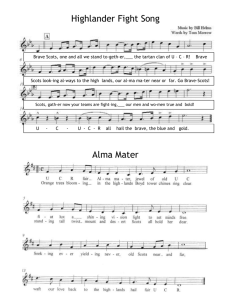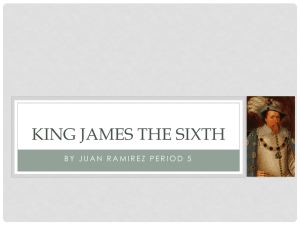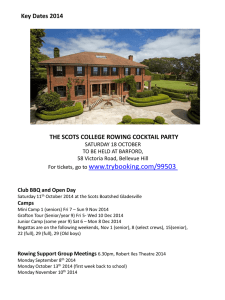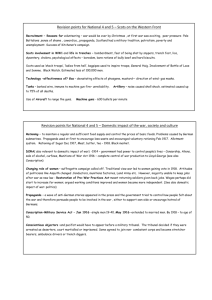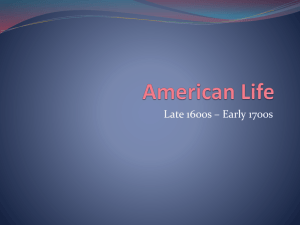Celebrating Scotland’s Scientists: A Scots language resource – Second level
advertisement
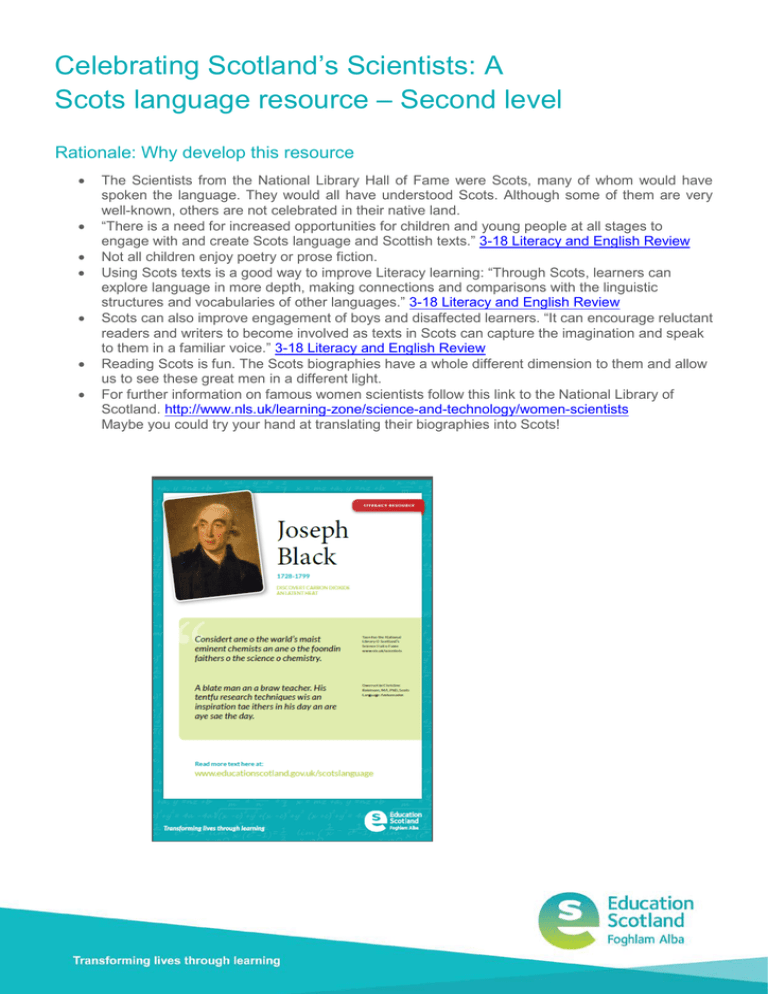
Celebrating Scotland’s Scientists: A Scots language resource – Second level Rationale: Why develop this resource • • • • • • • The Scientists from the National Library Hall of Fame were Scots, many of whom would have spoken the language. They would all have understood Scots. Although some of them are very well-known, others are not celebrated in their native land. “There is a need for increased opportunities for children and young people at all stages to engage with and create Scots language and Scottish texts.” 3-18 Literacy and English Review Not all children enjoy poetry or prose fiction. Using Scots texts is a good way to improve Literacy learning: “Through Scots, learners can explore language in more depth, making connections and comparisons with the linguistic structures and vocabularies of other languages.” 3-18 Literacy and English Review Scots can also improve engagement of boys and disaffected learners. “It can encourage reluctant readers and writers to become involved as texts in Scots can capture the imagination and speak to them in a familiar voice.” 3-18 Literacy and English Review Reading Scots is fun. The Scots biographies have a whole different dimension to them and allow us to see these great men in a different light. For further information on famous women scientists follow this link to the National Library of Scotland. http://www.nls.uk/learning-zone/science-and-technology/women-scientists Maybe you could try your hand at translating their biographies into Scots! Transforming lives through learning Skills for learning, life and work • • • Personal and learning skills, including thinking skills Literacy Core skills: communication, problem solving, information technology and working with others Purpose: Intended learning outcomes Literacy and English: Significant Aspects of Learning Listening and Talking • • • • Engages respectfully with others in different contexts by responding, questioning, contributing appropriately and building on ideas. Demonstrates a range of verbal and non- verbal skills, adapting to the needs of a range of audiences. Plans and creates spoken texts with increasing confidence and delivers to a variety of audiences. Identifies and discusses the main features of texts, makes and organises notes, using these to create texts appropriate to audience and purpose Reading • • • • • • Selects appropriate reading strategies to monitor and check understanding. Uses knowledge of language to read unfamiliar texts with understanding and expression. Asks and answers literal, inferential and evaluative questions about a text and uses supporting detail. Finds, selects, sorts and uses information from a variety of sources for a range of purposes. Makes and organises notes using own words and headings to solve problems, develop own thinking and create new texts. Identifies and discusses the writer’s style, use of language, and the effect this has upon the reader. Writing • • • • • • • • Writes independently for a range of purposes and audiences. Uses paragraphs to organise writing. Uses a variety of punctuation and sentence structures as appropriate to purpose. Uses a range of spelling strategies to ensure writing is mainly accurate. Uses layout and presentation to engage the reader. Checks throughout the writing process, taking account of purpose. Uses texts, including own notes, to evaluate and organise ideas and information in order to create new texts. Appropriately acknowledges sources. Uses and applies knowledge of conventions of genre, form, structure and style when creating a variety of texts, using language to suit purpose and engage the audience. Other Curricular Areas: Experiences and Outcomes • Expressive Arts - EXA 2-01a, EXA 2-16a, EXA 2-18a • Sciences - SCN 2-20a, SCN 2-20b • Social Studies - SOC 2-03a Transforming lives through learning Purpose: Intended learning outcomes 1. Use the biographies for traditional reading comprehension activities. 2. Use the biographies for Critical Reading, using Thinking Reader or an equivalent toolkit. 3. Record a biography and use it to form the basis of a listening comprehension. You could ask your Scots Language Ambassador or another volunteer to provide the reading, if you do not feel confident to read the Scots yourself. A learner with sufficient Scots could equally well provide the reading. For information on Ambassadors, email Katrina.Lucas@educationscotland.gsi.gov.uk 4. Compare the Scots and English biographies. This will give learners an insight into the translation process. It could be a springboard for translation of other text, their own or that of others. Translations of Alexander Fleming’s biography (available in English) are invited, in any variety of Scots. These should be submitted to Diane.Anderson@educationscotland.gsi.gov.uk by 10th December 2015. The best translation will be posted thereafter. Translations PowerPoint on Blether 5. Compare the different regional variations of Scots found across the different biographies. This will allow learners to see the variations in different areas of the country. It could be part of a Keen Tae Ken Yir Kin project, comparing Scots with a class of learners in another region of the country. Keen Tae Ken Yir Kin / Scots Language Centre Dialects 6. Explore the resource through song. There are songs on James Clerk Maxwell which could be learned and performed. Learners could develop their own for another scientist. Clerk Maxwell song in English / Rab Wilson documentary on Clerk Maxwell featuring Scots song 7. Create a GLOW profile page for one of the Scientists, using the information in the resource. This will encourage learners to find and use information as well as use their imaginations to create a new resource. 8. Fill the gaps. The scientists featured in the National Library Hall of Fame are all dead men. Yet there are many living Scottish Scientists who are at the top of their fields. Many of them are women. Learners could research these figures and produce a similar biography, in Scots and English and a poster, to celebrate their achievements. 9. Recreate the format for other famous Scots. When studying significant Scottish designers, for example, learners could produce biographies of them in Scots and English and a poster, to record their findings. Studying Scotland Those Scots who feature on our banknotes could be the subject of research. 10. Use the format for personal or creative writing. This could be an interesting new way to present “All about me” information. Learners could also record their ambitions for the future by imagining what a biography or poster on their achievements might look like in 10, 20, 50 or 100 years’ time. Transforming lives through learning 11. Choose the scientist with the most local or personal significance and undertake further research about him. There are parks and buildings named after these men. Their work has had farreaching effects on modern life. Learners could discover more and present their findings in an appropriate way: with a talk or a poster. 12. Have debate, in Scots or English about the relative importance of the various Scientists. This could take the form of a balloon debate: which should be first to leave a dangerously descending balloon, or a more traditional debate on which has contributed most to the world. 13. Use the resource as the basis of a Scots dictionary. Have learners record the vocabulary used in the biographies and the English equivalent word or phrase. This can then be used as the basis for future work in Scots. It can be added to over time. 14. Create a fictional interview for the BBC Science website using the information in the biographies. Learners can adopt roles as one of the scientists or as an interviewer. Interviews could be dramatised using costumes and props and/or recorded as podcasts. See BBC Science 15. Learners read up on/do further research on one of the Scientists each. They then take turns to interview each other to collect more information. They then present on the one they found out about by interview. 16. If two of the scientists met (and some of them knew each other) what might their conversation be? Design a comic strip of their conversation. 17. Quiz: who’s who? Give key pieces of information on some of the figures, and ask learners to figure out which scientist is being referred to. OR, have them learn all about each of the scientists and give them key facts and ask them to sort these under the correct scientist. 18. Learners draw the scientist being described in Scots by the teacher/a classmate. EG “He has a lang and stracht neb and is a bitty bald” OR have the scientist describe himself in Scots, in role play. EG “Ah hae a beard and a baldy heid – wha am I?” 19. Intergenerational work. Involve young people and adult learners in comparing and contrasting Scots words and dialects. 20. Use the resources to spark discussion, as a fun way in to looking at Scots. 21. Ask learners with English as an additional language if their mother tongue has any words they recognise in the Scots words. OR ask all learners to find any words they know/see/recognise in Scots which are connected to any foreign languages they know. 22. Use the resource as a starting point to challenge others to use more Scots in speech. Have learners issue the challenge to those they know. 23. Analyse why Scots is not valued more/spoken more in the media: why is this such an unusual resource? OR Analyse why all those voted for in the poll were dead men. Transforming lives through learning
